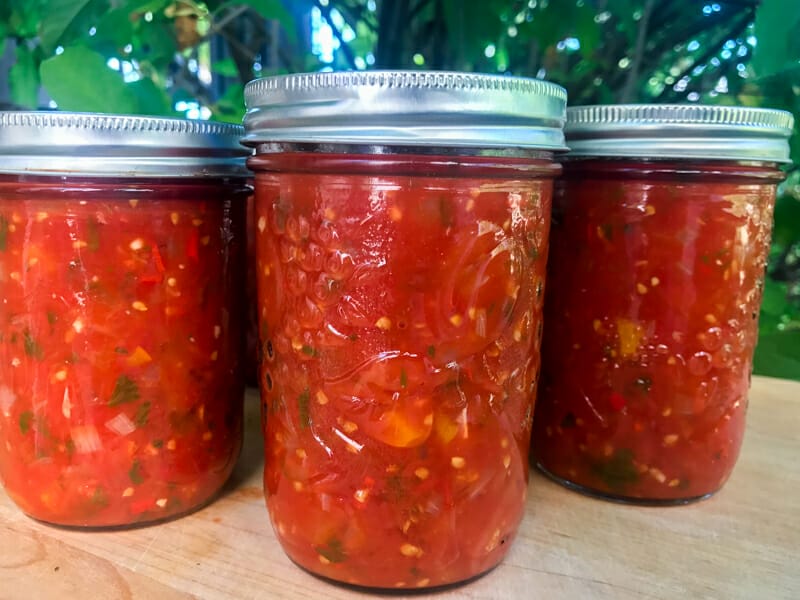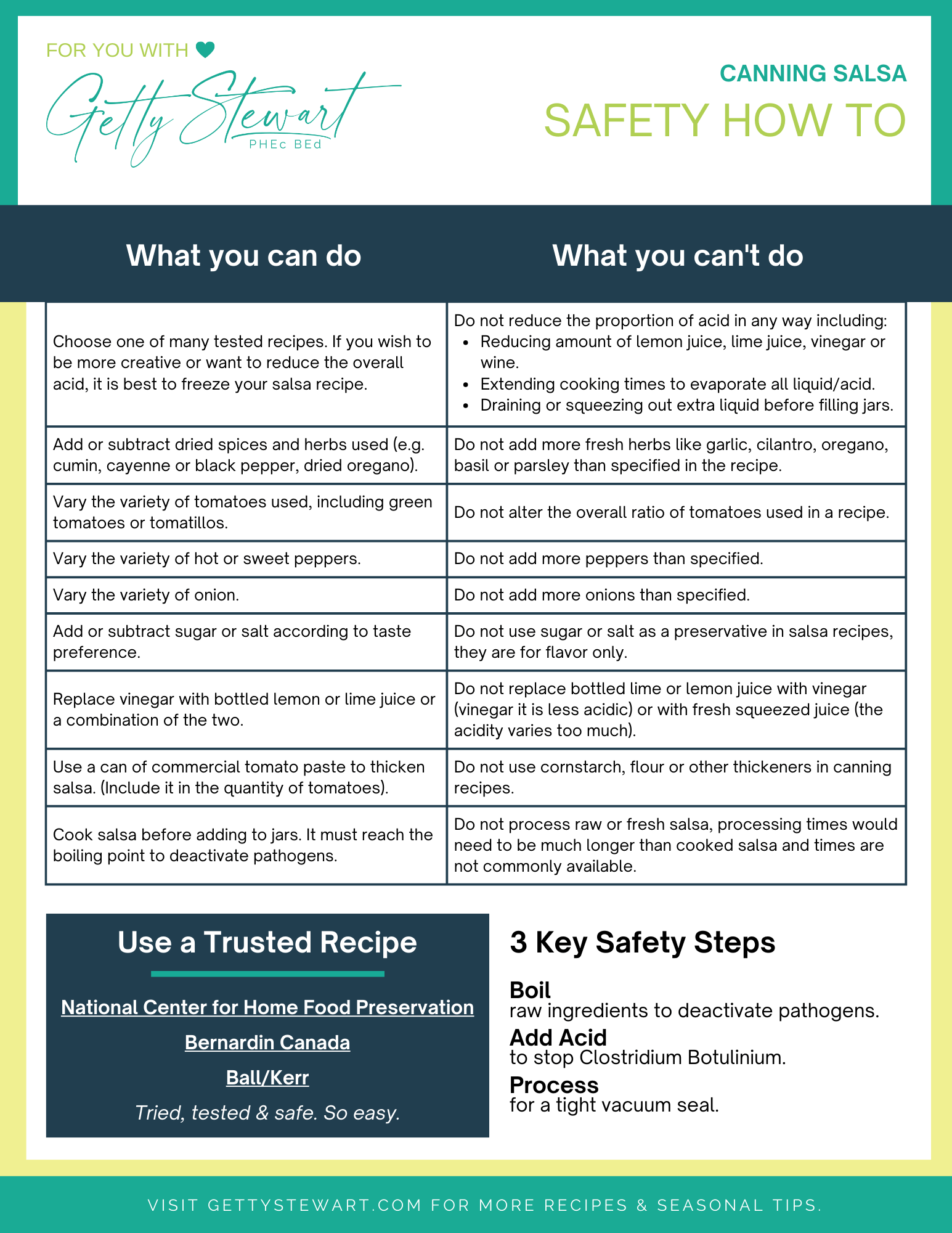How to Can Salsa Safely – Hot Water Bath Canning
Everything you need to know to can salsa safely. Be confident that what’s in your pantry will be safe for friends and family to enjoy.
Here’s a summary of the key Do’s and Don’ts to can salsa safely based on information from the National Center for Home Food Preservation.
My Go To Salsa Canning Recipe: Tomato Salsa with Paste Tomatoes – National Center for Home Food Preservation
Chart or no chart, the best advice for easy, safe homemade salsa is to find a tested recipe. Just follow it step by step and you’ll be good to go without any calculations or worries. Easy peasy! I’ve listed my favourite recipes from trusted sites in My Favourite Salsa Recipes. Or you can click directly to any of these sites.
- National Ctr for Home Food Preservation
- Bernardin Canada
- Ball/Kerr
Why is it Important to Can Salsa Safely?
The issue with canning salsa is that salsa contains many low acid ingredients. Even the tomatoes in salsa can vary greatly in acidity and are considered borderline low acid when it comes to canning.
Without the addition of the correct amount of acid, salsa is considered a low acid food. Low acid are not safe to can in a hot water bath canner due to the potential threat of pathogens like Clostridium Botulinum, the bacteria that causes botulism which can be fatal (read more here). This bacteria thrives in high moisture, low acid, low salt and low oxygen environments like salsa.
The good news is, it is easy to eliminate the risk of Clostridium Botulinum. You just need to add acid to make your canned goods unpleasant for this bacteria. How much acid to add is critical. Instead of guessing at the right amount of acid – use a tested recipe. Tested recipes have been tested for taste AND for acidity levels so that you can feel confident that your salsa will be safe. No guessing, no worries, no hesitation.

How Much Acid Is Needed?
Food should be at a pH of 4.6 or lower in order to be safe for water bath canning. Adding canned lemon juice, lime juice or vinegar is a way to add acid to low acid foods like salsa. Exactly how much to add to each jar varies based on the mix of ingredients in your salsa recipe. That’s the benefit of credible, tested recipes – they tell you exactly how much acid is needed based on the research they’ve done. Don’t guess how much acid is needed – just follow a tested recipe.
While we can make a few changes to a tested recipe (see above chart) it’s important to keep the overall proportion of acid to non-acid ingredients.
Can I test Acidity or pH at Home?
Yes, it is possible to test the pH (acid level) at home, but for most home canners it is not very practical, easy or affordable.
Two ways to measure acidity is with Litmus Paper (paper pH strips) or with a pH meter. Here’s a comparison of the two methods from sciencing.com.
When testing the acidity of pH, it’s important to test the liquid and any chunks that are in your salsa. If you choose this route, be sure to let the salsa rest for 12-24 hours and to puree the chunks so you get an accurate measure. Here’s what the pH paper manufacturers say about testing salsa.
And, if you’re using pH meters, remember to calibrate your machine according to the manufacturers instructions.
If this sounds too complicated, use a tested recipe from my favourite salsa recipes.
If I Have the Correct Acid Level, Do I Still Need to Hot Water Bath Salsa?
Yes. The hot water bath process creates a tight vacuum seal which ensures pathogens can’t enter the jar. It also takes care of other pathogens that aren’t affected by acid levels.
Here’s a step by step process for how to use the hot water bath canning method.
Because salsa is processed in jars for more than 10 minutes, jars do not need to be sterilized. While they don’t need to be sterilized, jars should be hot when filled so that the hot salsa goes in a hot jar which goes into the canner with hot water. Keeping everything the same temperature will prevent jars from cracking.
Can I Pressure Can Salsa Instead of Using a Hot Water Bath?
Pressure canning is usually an option for low acid vegetables. However, I haven’t found a tested recipe for pressure canned salsa. So, there’s no recommended processing time available. And following tested processing times is an important rule of safe canning. You can’t just make up times and acid levels if you want to be truly safe.
I suspect there are no tested recipes because the processing time required would overcook the salsa and lead to a poor quality product.
Do I REALLY Need to Bother, My Salsa Hasn’t Killed Anyone?
Yes, you really do! If you’ve been haphazard about canning your salsa, consider yourself lucky. But why push your luck?
Clostridium botulinum isn’t always present. Just like every time you drive a car you don’t get into an accident. But if it ever is present, which you would never know, safe canning is like having an airbag and seatbelt if you get into an accident. It will save your life.
Be smart. Can salsa safely.
What If I Have Canned Salsa that Doesn’t Quite Meet the Guidelines?
That salsa is at risk. There is no way to detect if Clostridium Botulinum is present. If it is within 24 hours, you can empty the jars and freeze the salsa. After that, there’s not much that can be done. Sorry, wish it were otherwise.
Why Does the Salsa Need to Boil Before Being Canned?
I haven’t found a tested recipe for raw or fresh salsa. If you do find one, the recommended processing time is likely two or three times longer than processing cooked salsa. Just think of the time it will take to get cold, raw salsa in a cold jar in cold water in your canner to come to a boil – 60 minutes at least. And that’s before you start the processing time. It would take nearly two hours on the stove, much better to the cook the salsa.
What if I Don’t Like the Texture or Taste of Safely Canned Salsa?
First, try a different tested recipe. There are well over 20 different recipes in the three sites I recommend. There’s bound to be one that you like.
Second, as the chart shows, there are some safe alterations that you can make that will change the flavor of a recipe. Try some different herbs and spices. Mix and match pepper varieties or tomato varieties. Add a little sugar to take out the bite of acid. Mix lemon juice and lime juice to get a different flavor profile.
Third, touch up the canned salsa just before serving. Drain off extra liquid, add some more hot sauce or hot pepper flakes, add some fresh mango, chop in some fresh cilantro, serve with a wedge of lime, etc. You’re no slouch in the kitchen – use those skills once you open the jar of salsa. That’s the time to get creative.

Any way you slice it. To can salsa safely, there are certain procedures you just need to follow. Doing otherwise is putting you and your loved ones at risk. The choice is yours.
If you need more information, want to talk it through or want a demonstration, leave a comment or email me. I’d be happy to teach you or a group how to can salsa safely in your home or in a workshop. You can reach me at [email protected].
Sign up to get articles by Getty delivered to your inbox. You’ll get recipes, practical tips and great food information like this. Getty is a Professional Home Economist, speaker and writer putting good food on tables and agendas. She is the author of Manitoba’s best-selling Prairie Fruit Cookbook, Founder of Fruit Share, a mom and veggie gardener.



We just canned a bunch of salsa. We didn’t hit water bath it but all of our jars sealed. Can you hot water bath the day after?
If it’s been 24 hours you could reheat the food, return it to the jars and process as recommended. If you take your existing jars and put them in a hot water bath, it would take a LONG time to get the jars in the canner to a boiling point and then to get the contents of the jars to the correct temperature. As far as I know there is no safe, tested process for doing this and no recommendation regarding how long to process them, so I would not recommend that.
Question?
I just caned and water bathed 7 pints of salsa and by mistake I put 1/2 t.s. Per pint instead of 1/4 t.s. Per pint of citric acid.is there a problem with adding too much citric acid.the recipe also had 3/4 cup o white vinegar and 1/4 cup of lime juice.
Thank you for your site it is very educational…..
Ken
Hi Ken, Just to clarify, did you add the vinegar and lime juice as indicated in the recipe? If so, adding too much citric acid is WAY better than not adding enough acid. You may find that when you open the jars the salsa may taste very tart. You can add some tomato paste and/or sugar to balance out the flavour. But as long as it was a recipe from a trusted source and the overall amount of acid is MORE not less, it should be safe.
Hi. We have an amazing salsa recipe that we have used for years. Apart from changing the recipe to fire roast all vegetables on the smoker first, we have not altered anything regarding the acid ratio etc. I never knew we needed to water bath salsa. My question is can I take my tried and true recipe that everyone loves and water bath it to make it safe? Does that work or do I need a different recipe?? Please help!!!
Hi Sandra,
I don’t know how roasting veggies changes the acidity of the vegetables. Do you know the source of the original recipe, if so, check with them or the National Center for Home Food Preservation. You can also try your luck at one of the canning hotlines run by the USDA state agencies. 1-800-354-7319.
Hi. We have an amazing salsa recipe that we have used for years. Apart from changing the recipe to fire roast all vegetables on the smoker first, we have not altered anything regarding the acid ratio etc. I never knew we needed to water bath salsa. My question is can I take my tried and true recipe that everyone loves and water bath it to make it safe? Does that work or do I need a different recipe?? Please help!!!
It’s good to know that you actually need to boil your salsa. We actually just made salsa for the first time and we had it boiling for a few hours. It was a lot of work but the salsa was amazing.
Sounds delish!
Hi Getty,
I have a question for you, is it ok to freeze in glass jars? I am assuming yes, but now am rethinking it.
Thanks for your expertise.
Kathy
Hi Kathy,
Yes, you can freeze in glass jars. It’s best to use straight sided jars without the shoulder on the top or leave plenty of expansion room – 1 to 2 inches. Remember food will expand when frozen, you don’t want the expanded food to press on the shoulder of the jar and potentially crack it. Also, make sure you place the jars where they won’t fall or get jostled about – broken glass in the freezer really sucks (been there, done that!).